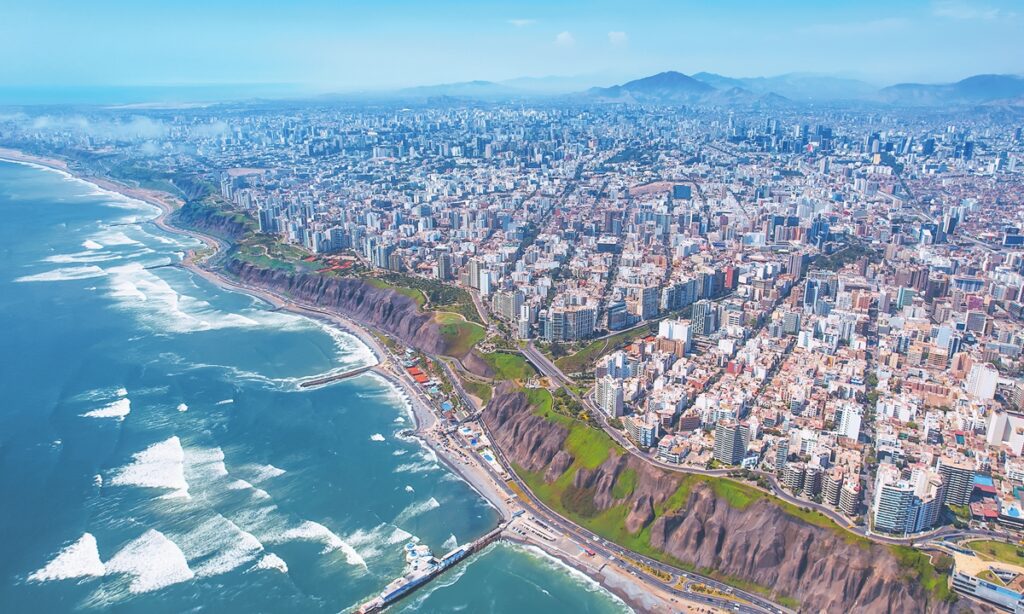An aerial view of coastline in Lima, Peru Photo: VCG
Whether because of the language barrier or limited local news coverage, people in Lima, capital of Peru, and Rio de Janeiro in Brazil, appear to be unfamiliar with the Belt and Road Initiative (BRI), unlike many places in Asia and Africa, where mention of the BRI often prompts locals to raise their thumbs.
In Lima, when asked whether they had heard of the BRI, some simply shook their heads. In Rio de Janeiro, when asked the same question, a local worker said he had heard of it but was unsure of its details, although he noted that Brazil and many countries in Latin America increasingly recognize the importance of boosting economic cooperation with China.
However, that does not mean there is a lack of interest in carrying out BRI cooperation. On the contrary, in interviews with the Global Times, local residents, journalists and officials voiced interest in expanding cooperation with China – from infrastructure and investment to trade. And many were quick to share their excitement about major cooperation projects with China, without directly referencing the BRI.
On a bustling Wednesday morning at the Mercado Lobaton, one of the largest markets in Lima, where locals come to buy their daily groceries, many vendors recognized the significance of Chinese consumers across the Pacific Ocean.
“This is for export to China,” Percy Pena Angeles, a vendor at the market, told the Global Times while pointing to a bag of blueberries. He also showed chili peppers and garlic bulbs that will be exported to China.
When asked whether selling agricultural products for local consumers at the market or exporting to China brings them more money, Angeles gestured counting money and confidently replied: “Export!”
At the G20 International Media Center in Rio de Janeiro, which was packed with journalists from around the world, Márcio Macêdo, chief minister of the General Secretariat of the Presidency of Brazil, emphasized the importance of China-Brazil friendly relations, when asked about talks between Chinese and Brazilian leaders.
“Having these talks, both geopolitically and economically, is fundamental for evolution in Brazil’s exports and also help us to develop our country’s economy to create jobs and income,” Macêdo said.
Deeper roots
During the Chinese leader’s visits to Peru and Brazil, two milestones marked progress in BRI cooperation with Peru, Brazil, and the broader Latin America region.
On November 15, China and Peru inaugurated the Chancay Port, a flagship project under BRI cooperation framework which further enhances long-standing, deep connections between the two countries. The connection represents more than the BRI’s establishment in Peru, but the birth of a new Asia-Latin America land-sea corridor.
China will work with Peru to build a land-sea corridor between China and Latin America with Chancay Port as a starting point.
Located about 80 kilometers north of Lima, Chancay is a leading deep-water port and the first smart and green port in South America. It is set to become a key Pacific gateway for Latin America. Its benefits are recognized by many small businesses in Lima, like Angeles’ business.
Angeles said that Peruvian exports currently transit through Panama before reaching Chinese and other markets, but Chancay Port will allow fresh Peruvian produce to arrive in Shanghai much faster at a much lower cost.
Another milestone for China-Latin American BRI cooperation was also reached on Wednesday, as China and Brazil have decided to establish synergies between the BRI and Brazil’s own development strategies.
Brazil is one of the few South American nations yet to participate in the BRI, so this again demonstrates the growing attractiveness of the BRI in Latin America and its power to expand cooperation. It also means that the BRI is gaining deeper roots in Latin America.
Many Latin American countries have already joined the initiative, with 22 of the 26 countries in the region that have diplomatic relations with China having signed memoranda of understanding with China on BRI cooperation. This BRI cooperation between China and the region is set to expand further.
A view of Chancay Port, Peru on October 29, 2024 Photo: VCG
Growing attractiveness
During high-level talks between China and several Latin American countries on the sidelines of the just-concluded G20 Summit held in Rio de Janeiro, the leaders stressed efforts to further expand BRI cooperation.
In talks with Argentine President Javier Milei, the Chinese leader said that China is willing to work with Argentina to promote high-quality BRI cooperation. In talks with Bolivian President Luis Arce, the Chinese leader pledged to promote high-quality BRI cooperation and highlighted the tangible benefits of Belt and Road cooperation with Bolivia, aligning it with Bolivia’s 2025 development plan.
At the APEC Economic Leaders’ Meeting in Lima and the G20 Summit in Rio de Janeiro, where countries and regions strived for cooperation and development, China’s BRI and other initiatives, including the Global Development Initiative, have become even more attractive for many economies in the world.
In interviews with officials, reporters and ordinary residents, it was palpable that China offers a sense of stability and represents great opportunities, while political transition in the US has created profound uncertainties for the world.
Against such a global backdrop and the concerted efforts by both sides, China-Latin America BRI cooperation is about to enter the fast lane. Following its success in many parts of Asia and Africa, the BRI is set to break through the language barrier in Latin America and become a catchphrase signifying win-win cooperation.
Source link : http://www.bing.com/news/apiclick.aspx?ref=FexRss&aid=&tid=6740c601039c4b9685a3c674d3287251&url=https%3A%2F%2Fwww.globaltimes.cn%2Fpage%2F202411%2F1323625.shtml&c=10847292505055418898&mkt=en-us
Author :
Publish date : 2024-11-22 03:07:00
Copyright for syndicated content belongs to the linked Source.
